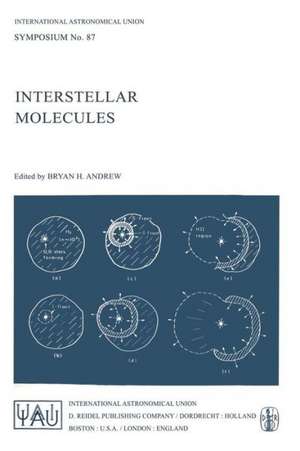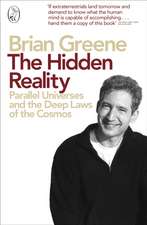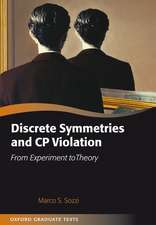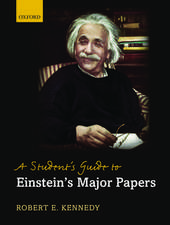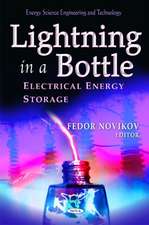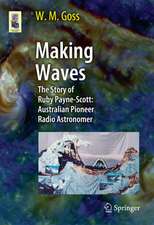Interstellar Molecules: International Astronomical Union Symposia, cartea 87
Editat de J. Andrewen Limba Engleză Paperback – 14 dec 2011
Din seria International Astronomical Union Symposia
-
 Preț: 132.74 lei
Preț: 132.74 lei -
 Preț: 404.67 lei
Preț: 404.67 lei -
 Preț: 400.65 lei
Preț: 400.65 lei -
 Preț: 412.95 lei
Preț: 412.95 lei - 15%
 Preț: 660.68 lei
Preț: 660.68 lei - 15%
 Preț: 654.43 lei
Preț: 654.43 lei -
 Preț: 407.98 lei
Preț: 407.98 lei - 18%
 Preț: 1238.74 lei
Preț: 1238.74 lei - 15%
 Preț: 659.53 lei
Preț: 659.53 lei -
 Preț: 409.89 lei
Preț: 409.89 lei - 18%
 Preț: 1556.77 lei
Preț: 1556.77 lei - 18%
 Preț: 1852.43 lei
Preț: 1852.43 lei - 18%
 Preț: 1235.57 lei
Preț: 1235.57 lei -
 Preț: 419.14 lei
Preț: 419.14 lei -
 Preț: 414.52 lei
Preț: 414.52 lei -
 Preț: 417.41 lei
Preț: 417.41 lei - 15%
 Preț: 647.73 lei
Preț: 647.73 lei - 18%
 Preț: 967.56 lei
Preț: 967.56 lei - 18%
 Preț: 1236.06 lei
Preț: 1236.06 lei -
 Preț: 407.39 lei
Preț: 407.39 lei - 15%
 Preț: 654.12 lei
Preț: 654.12 lei -
 Preț: 416.26 lei
Preț: 416.26 lei - 18%
 Preț: 960.78 lei
Preț: 960.78 lei - 18%
 Preț: 1239.67 lei
Preț: 1239.67 lei - 18%
 Preț: 1239.85 lei
Preț: 1239.85 lei -
 Preț: 416.26 lei
Preț: 416.26 lei -
 Preț: 421.82 lei
Preț: 421.82 lei - 18%
 Preț: 1238.42 lei
Preț: 1238.42 lei -
 Preț: 416.26 lei
Preț: 416.26 lei -
 Preț: 405.28 lei
Preț: 405.28 lei - 18%
 Preț: 1220.54 lei
Preț: 1220.54 lei - 18%
 Preț: 1239.19 lei
Preț: 1239.19 lei - 18%
 Preț: 961.41 lei
Preț: 961.41 lei -
 Preț: 407.39 lei
Preț: 407.39 lei - 18%
 Preț: 961.86 lei
Preț: 961.86 lei - 15%
 Preț: 652.49 lei
Preț: 652.49 lei - 18%
 Preț: 1238.74 lei
Preț: 1238.74 lei - 18%
 Preț: 962.49 lei
Preț: 962.49 lei
Preț: 414.14 lei
Nou
Puncte Express: 621
Preț estimativ în valută:
79.25€ • 82.95$ • 65.96£
79.25€ • 82.95$ • 65.96£
Carte tipărită la comandă
Livrare economică 31 martie-14 aprilie
Preluare comenzi: 021 569.72.76
Specificații
ISBN-13: 9789400990999
ISBN-10: 9400990995
Pagini: 748
Ilustrații: 744 p.
Dimensiuni: 155 x 235 x 39 mm
Greutate: 1.03 kg
Ediția:Softcover reprint of the original 1st ed. 1980
Editura: SPRINGER NETHERLANDS
Colecția Springer
Seria International Astronomical Union Symposia
Locul publicării:Dordrecht, Netherlands
ISBN-10: 9400990995
Pagini: 748
Ilustrații: 744 p.
Dimensiuni: 155 x 235 x 39 mm
Greutate: 1.03 kg
Ediția:Softcover reprint of the original 1st ed. 1980
Editura: SPRINGER NETHERLANDS
Colecția Springer
Seria International Astronomical Union Symposia
Locul publicării:Dordrecht, Netherlands
Public țintă
ResearchCuprins
Physical and Dynamical Conditions in Interstellar Clouds.- Detection of Submillimeter Lines of CO (0.65 mm) and H2O (0.79 mm).- New Detections of Spectral Lines in the Frequency Range 260–285 GHz.- Further Observational Studies of the High Velocity Molecular Source (“Plateau”) in Orion.- High Velocity Gas in the Orion Nebula.- High Spatial Resolution Studies of H13CN, H12CN and HCO+ J= 1?0 Emissions in Orion A.- Lunar Occultation Observations of Millimeter CO Emission in S255.- Radio-Frequency Observations of Interstellar CH4 and HC5N.- On the Identification of Mm-Wavelength U-Lines.- Long Chain Carbon Molecules in the Interstellar Medium.- Long Carbon Chain Molecules in the Laboratory and in Space.- The Relative Distribution of Ammonia and Cyanobutadiyne Emission in Heiles 2 Dust Cloud.- Observations of HC5N (J=12?11 and 13?12) and HC7N (J=28?27), including a Detection of B335.- Spectra of the 10–01 Transition of Sulfur Monoxide in Interstellar Clouds.- CN Observations in Taurus Dark Cloudlets.- C2H and HC3N in Interstellar Clouds.- Detection of New Ammonia Sources.- Ammonia Observations of the Molecular Clouds near S68, S140 and OMC2.- Ammonia Observations of the Molecular Cloud near S106.- The Core of a Quiescent Cloud, L183.- Observations of NH3 toward DR21.- High Resolution 4.8 GHz Mapping of H2CO using the Westerbork Synthesis Radio Telescope.- Surveys of the 4.8 GHz Formaldehyde Absorption Line in Dark Clouds in M17 and NGC 2024.- Cloud-to-Cloud Variations in H2CO-to-H2 Ratios.- Formaldehyde in L1551, L134 and the Galactic Centre.- Observations of the 3.4-mm HCO+ Line toward the Galactic Centre.- CO and OH in the Galactic Center Region.- In Search of ? 5K Galactic Molecular Gas.- CO (J=2?1) Observations of Several Galactic HII Regions.-Molecular Cloud Densities from Observations of Carbon Monosulfide.- CO Observations in the Southern Hemisphere.- CO (J=2?1) Observations of the Carina Nebula and G 333.6-0.2 and a Search for CO in LMC and SMC.- Population Inversion and Suprathermal Excitation in Carbon Monoxide.- 1.0 mm Continuum Observations of Cool Southern Clouds.- The Extinction Efficiency of Dust Grains at 1 Mm.- Comparison of Submillimeter and CO Brightness in Orion and Mon R2.- The Evolution of Giant Molecular Clouds.- The Disruption of the Molecular Cloud Associated with the North America and Pelican Nebulae.- The Structure and Evolution of the W3 Molecular Cloud.- Atomic Hydrogen in and around the Giant Molecular Cloud near W3 and W4.- High Rate of Destruction of Molecular Clouds by Hot Stars.- The Interaction of T-Tauri Stars with Molecular Clouds.- Observations of the J=1?0 and J=2?1 Lines of 12CO in L1551: Evidence for Anisotropic Mass Loss.- Ammonia Observations of Dark Clouds containing Herbig-Haro Objects.- Hydrostatic Models of Molecular Clouds.- Contagious B Star Formation in the Rho Ophiuchi Dark Cloud.- A Nearby Example of a Giant Molecular Cloud.- Cold HI Gas in the Region of the Giant Molecular Cloud near M17.- Search for CO in Atomic Hydrogen Clouds.- Optical and Theoretical Studies of Giant Clouds in Spiral Galaxies.- Molecular Clouds in Orion and Monoceros.- Columbia CO Survey: Molecular Clouds and Spiral Structure.- Molecular Fan of 360-pc Radius in the Galactic Center Region.- The Galactic Rotation Curve to R = 18 kpc.- The Hydrogen Molecule as a Collision Partner.- Recent Laboratory Work on Molecules of Possible Importance for Interstellar Studies.- Far Infrared Laser Magnetic Resonance Spectroscopy.- Optical Observations of Interstellar Molecules.- Observations ofInterstellar Molecules with the International Ultraviolet Explorer.- Interstellar Line Spectra of a Dense Cloud: The VI Cygni Association.- Rotational Fine Structure Lines of Interstellar C2 toward ? Persei.- Laboratory Measurements of Oscillator Strengths of Ultraviolet Molecular Lines of HC1 and H2O and Column Densities of These Molecules in the Zeta Ophiuchi Cloud.- Chlorine Chemistry in Diffuse Interstellar Clouds.- Molecular Formation in Hot Diffuse Clouds.- Formation of Simple Molecules by C+ Reactions on Oxide Grains in Diffuse Clouds.- The Photodissociation of Interstellar CH+.- Charge Exchange and Fine Structure Excitation in O-H+ Collisions.- Molecular Synthesis in Interstellar Clouds: the Radiative Association Reaction H+OH ? H2O+h?.- Experimental Measurements of Ion-Molecule Reactions.- Interstellar Sulfur Chemistry.- An ICR Study of Ion-Molecule Reactions in the C2H2/HCN System.- An ICR Study of an Association Reaction at Low Pressure.- Laboratory Studies of Interstellar Carbon/Nitrogen Ion Chemistry.- Gas Phase Synthesis of Amino-, Cyano- and Nitroso-Compounds in Interstellar Clouds.- The Formation of Complex Interstellar Molecules by Radiative Association.- The Formation of Interstellar Molecules via Radiative Association Reactions.- On the Formation of Interstellar Linear Molecules.- Laboratory and Modeling Studies of Chemistry in Dense Molecular Clouds.- Molecular Evolution in Dense Clouds.- The Determination of Electron Abundances in Interstellar Clouds.- Molecule Formation in Cool, Dense Interstellar Clouds.- Laboratory and Theoretical Results on Interstellar Molecule Production by Grains in Molecular Clouds.- Interstellar Molecules on Dust Mantles.- The Formation of Hydrocarbons and Iron— Hydrides on Cold Interstellar Grains — ExperimentalStudies.- The Chemical Identification of Grain Mantles by Infrared Spectroscopy.- Infrared Molecular Absorption Features.- Reproduction of the Interstellar Ice Band by Grain Mantle Analogs.- Correlations between the ?2200 Feature, the Diffuse ?4430 Band and EB-V.- Correlations for Interstellar Molecules and Diffuse Bands.- Measurements of Isotopic Abundances in Interstellar Clouds.- Isotopic Abundance Ratios from Microwave Observations of Formaldehyde.- Isotope Ratios in Interstellar Formaldehyde.- The 12C/13C Ratio in Interstellar Dark Clouds.- CO Abundance and Isotopic Fractionation in Dark Clouds.- CO Isotope Line Shapes in Dark Clouds.- Isotopic Fractionation in Interstellar Carbon-bearing Molecules Unrelated to Carbon Monoxide.- Interpretation of Isotopic Abundances in Interstellar Clouds.- Detection of Deuterated Formaldehyde in Interstellar Clouds.- Theoretical Considerations of Shock Wave Behavior.- Observations of Shock Waves in Interstellar Clouds.- Observations of the V=0 S(2) Line of Molecular Hydrogen at 12.28 ?m in the Orion Molecular Cloud.- Spectra of the 2.12 µm Quadrupole Line of H2 in the Orion Molecular Cloud.- Molecule Formation in the Seyfert Galaxy NGC 1068.- Molecular Clouds near Supernova Remnants.- Behavior and Significance of Circumstellar Clouds.- Observations of Circumstellar Clouds.- Radio Detection of Ammonia in IRC+10216.- Molecular Abundances in IRC+10216.- Infrared Heterodyne Spectroscopy of Circumstellar Molecules.- Spectroscopic Studies of IRC+10216 and Similar Objects.- Infrared Spectroscopy of Molecules in Circumstellar Material.- Observational Characteristics of Masers Associated with Stars.- VLBI Observations of the V=1 and V=2 SiO Masers in W Hydra and VX Sagittarius.- Vibrationally Excited Silicon Monoxide Masers.- TimeVariation of SiO Maser Emissions.- Time Variability of the Orion A, R Leo and o Ceti SiO (v=1, J=2?1) Masers.- Polarized Emission in the Broad SiO Feature from R Leo.- SiO Emission from the Orion Nebula.- The OH Circumstellar Maser in Late-Type Stars.- Interpretation of Circumstellar Masers.- Pumping Mechanisms of OH Masers.- Observations of Masers in Regions of Star Formation.- Absolute Positions of OH Masers Associated with HII Regions.- The Pumping of Interstellar OH Main Line Masers: an Efficient Mechanism.- ?-Doublet Population Inversion in Collisions of OH, OD, CH, CD and NH+.- Collisional Inversion of the Populations of ?-Doublets in CH and OH: a Critical Study.- Pumping of Strong H2O Cosmic Masers.- Time Variations of Interstellar Water Masers in HII Regions.- Further Observations of the H2O Emission from NGC 4945.- The Interpretation of High Velocity H2O Masers.- Far-Ultraviolet Objective Spectrographs Surveys for Mapping of Interstellar H2, H, and CO.- Future Possibilities for Ultraviolet Observations of Interstellar Molecules.- Maser Amplifiers.- Wideband Spectrometers for Millimetre Wavelengths.- Acousto-Optic Radiospectrometers for Mm-Wave Spectroscopy.- Future Spectral Line Research with the VLA.- New Experimental Possibilities and Future Prospects for 1–5µm Infrared Spectroscopy of Interstellar Molecules.- A 10 Micron Heterodyne Receiver for Ultra High Resolution Astronomical Spectroscopy.- New Experimental Possibilities and the Future at Far IR Wavelengths.- Detection of Interstellar BS in the Cirrus Dark Cloud of the Numbbum Association I — An Intuitive Model and Its Subsequent Observation.- Author Index.- Index of Astronomical Objects.- Molecules Index.
